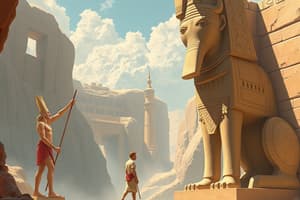Podcast
Questions and Answers
The Colossal Figure of Akhenaten demonstrates characteristics that distinguish the Amarna style in all of the following EXCEPT:
The Colossal Figure of Akhenaten demonstrates characteristics that distinguish the Amarna style in all of the following EXCEPT:
- The portrayal of the royal family
- The monumental scale of the figure (correct)
- The use of elongated forms
- The emphasis on realism
Egyptian Books of the Dead were written?
Egyptian Books of the Dead were written?
on papyrus scrolls
The Egyptian stepped pyramid is similar to the ziggurats of Mesopotamia in?
The Egyptian stepped pyramid is similar to the ziggurats of Mesopotamia in?
height
The Egyptians used a canon of proportions to?
The Egyptians used a canon of proportions to?
The Great Sphinx at Giza is a colossal portrait of which Old Kingdom ruler?
The Great Sphinx at Giza is a colossal portrait of which Old Kingdom ruler?
The Funerary Temple of Hatshepsut shared all of the following with Egyptian pyramids EXCEPT it:
The Funerary Temple of Hatshepsut shared all of the following with Egyptian pyramids EXCEPT it:
All of the following were part of the mummification process used in ancient Egypt EXCEPT:
All of the following were part of the mummification process used in ancient Egypt EXCEPT:
Which of the following best explains the stylistic continuity seen in ancient Egyptian art?
Which of the following best explains the stylistic continuity seen in ancient Egyptian art?
A serdab is a?
A serdab is a?
In the decoration of Nefertari's tomb at Abu Simbel, the artist diverged from Egyptian decorative convention by?
In the decoration of Nefertari's tomb at Abu Simbel, the artist diverged from Egyptian decorative convention by?
Flashcards are hidden until you start studying
Study Notes
Amarna Style and Akhenaten
- The Colossal Figure of Akhenaten showcases traits of the Amarna style, but not its monumental scale.
Egyptian Books of the Dead
- These texts were traditionally inscribed on papyrus scrolls, serving as guides for the afterlife.
Stepped Pyramids vs. Ziggurats
- The Egyptian stepped pyramid shares height similarities with the ziggurats found in Mesopotamia.
Canon of Proportions
- Ancient Egyptian artists utilized a canon of proportions to maintain an organized and idealized representation of human figures.
The Great Sphinx
- The Great Sphinx at Giza is a colossal representation of the Old Kingdom ruler Khafre.
Funerary Temple of Hatshepsut
- The Funerary Temple of Hatshepsut, unlike Egyptian pyramids, did not primarily serve as a means of propaganda for asserting the ruler's authority.
Mummification Process
- The mummification process in ancient Egypt included many techniques, but the application of dark paint or powdered makeup to the skin was not part of it.
Stylistic Continuity in Egyptian Art
- The lasting stylistic continuity in ancient Egyptian art can be attributed to the political and cultural stability provided by the dynastic rule.
Serdab Definition
- A serdab is a small, sealed room located in a mastaba, specifically designed to house the ka statue of the deceased.
Nefertari's Tomb Decoration
- In Nefertari's tomb at Abu Simbel, the artist broke from traditional Egyptian decorative conventions by employing changes in hue to create a sense of three-dimensionality.
Studying That Suits You
Use AI to generate personalized quizzes and flashcards to suit your learning preferences.




